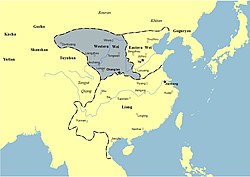
Back Qərbi Vey Azerbaijani باتی وئی سولالهسی AZB Tiernezh Wei ar C'hornôg Breton Wei occidentals Catalan Westliche Wei-Dynastie German وی غربی Persian Läntinen Wei-dynastia Finnish Dynastie Wei de l'Ouest French Zapadni Wei Croatian Wei Barat ID
Wei 魏 | |||||||||||
|---|---|---|---|---|---|---|---|---|---|---|---|
| 535–557 | |||||||||||
 Western Wei and neighbors | |||||||||||
| Capital | Chang'an | ||||||||||
| Government | Monarchy | ||||||||||
• 535–551 | Emperor Wen of Western Wei | ||||||||||
• 552–554 | Emperor Fei of Western Wei | ||||||||||
• 554–557 | Emperor Gong of Western Wei | ||||||||||
| Historical era | Southern and Northern Dynasties | ||||||||||
• Establishment of Eastern Wei, start of division of Northern Wei | 8 November 534[2] | ||||||||||
• Emperor Wen's ascension, often viewed as establishment | 18 February 535[1] 535 | ||||||||||
• Disestablished | 14 February 557[3] 557 | ||||||||||
| Currency | Chinese coin, Chinese cash | ||||||||||
| |||||||||||
| Today part of | China | ||||||||||
| Part of a series on the |
| History of China |
|---|
Wei (/weɪ/), known in historiography as the Western Wei (Chinese: 西魏; pinyin: Xī Wèi), was an imperial dynasty of China that followed the disintegration of the Northern Wei. One of the Northern dynasties during the era of the Northern and Southern dynasties, it ruled the western part of northern China from 535 to 557. As with the Northern Wei dynasty that preceded it, the ruling family of the Western Wei were members of the Tuoba clan of the Xianbei.